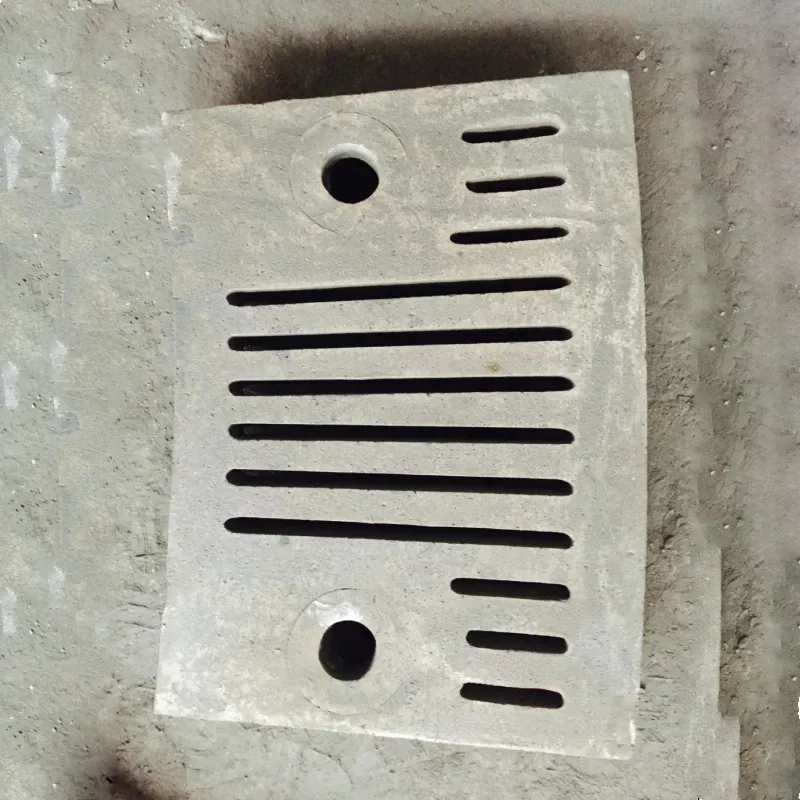Oct . 07, 2025 23:40 Back to list
High Manganese Steel Liners | Shijiazhuang Chengda|Wear Resistance, Impact Protection
Introduction to High Manganese Steel Liners
High Manganese Steel (HMS) lining plates, also known as Hadfield steel, are engineered to withstand extreme industrial conditions. These specialized materials are designed for applications where resistance to impact, abrasion, and wear is critical. Shijiazhuang Chengda Wear Resistant Materials Co., Ltd, a leading manufacturer in this field, offers high-manganese steel grates and linings that excel in environments ranging from mining operations to heavy machinery. This article explores the technical specifications, advantages, and applications of these robust materials, supported by authoritative references from the National Institute of Standards and Technology (NIST).

Key Features of High Manganese Steel Liners
High Manganese Steel is distinguished by its unique chemical composition and mechanical properties. The material typically contains 10%-15% manganese and 0.90%-1.50% carbon, with carbon content often exceeding 1.0%. This combination provides exceptional strength and toughness, making it ideal for high-impact environments. When subjected to severe stress, the surface of the steel rapidly hardens, while the core remains tough. This dual property—surface hardness and internal toughness—ensures long-term durability and resistance to wear.
One of the most remarkable characteristics of HMS is its ability to undergo secondary surface hardening after initial wear. This self-reinforcing mechanism enhances its longevity in applications where continuous abrasion is inevitable. The material’s performance has been validated through extensive research, including studies by NIST, which highlights its suitability for critical industrial applications.

Technical Specifications
| Parameter | Specification |
|---|---|
| Chemical Composition | Manganese: 10%-15%, Carbon: 0.90%-1.50% |
| Hardness (Surface) | 300-400 HB |
| Toughness (Core) | High impact resistance |
| Operating Temperature Range | -40°C to 500°C |
| Wear Resistance | Excellent under abrasive conditions |
| Applications | Mineral processing, construction, military, power generation |
Advantages of High Manganese Steel Liners
The advantages of high-manganese steel liners are multifaceted. Their superior impact resistance makes them ideal for use in SAG (Semi-Autogenous Grinding) mills, where large rocks and ore fragments are processed. Unlike conventional materials, HMS maintains its structural integrity under repeated stress, reducing the frequency of replacements and maintenance costs.
Another significant benefit is the material’s longevity. The self-hardening property ensures that even after prolonged use, the surface remains resistant to wear. This is particularly valuable in industries like mining and metallurgy, where equipment failure can lead to costly downtime. Additionally, the high toughness of HMS allows it to absorb energy from impacts without fracturing, further enhancing its reliability.
According to a NIST study on material performance under extreme conditions, high-manganese steel exhibits "exceptional resilience to dynamic loading," making it a preferred choice for applications requiring sustained durability.
Applications in Critical Industries
High Manganese Steel linings are extensively used in industries where equipment is exposed to harsh conditions. In the mining sector, these materials are employed in ball mills and SAG mills to grind ores and minerals. Their ability to withstand abrasive forces ensures consistent performance, even in the most demanding environments.
The construction industry also benefits from HMS linings, particularly in crushers and conveyor systems. The material’s resistance to wear reduces the need for frequent repairs, improving operational efficiency. In the military and defense sectors, HMS is used in armor plating and vehicle components, where its toughness and impact resistance are critical.
Modern advancements have expanded the use of HMS beyond traditional applications. For instance, it is now integrated into magnetic levitation trains and rock drilling robots, as noted in NIST research on material innovation.
About Shijiazhuang Chengda Wear Resistant Materials Co., Ltd
Shijiazhuang Chengda Wear Resistant Materials Co., Ltd is a reputable manufacturer specializing in high-performance wear-resistant materials. With years of expertise in ball mill liners and grate plates, the company has established itself as a trusted supplier in the industrial sector. Their products are designed to meet the stringent demands of mining, metallurgy, and construction industries.
The company’s commitment to quality is reflected in its adherence to international standards. By leveraging advanced manufacturing techniques and rigorous quality control, Shijiazhuang Chengda ensures that its products deliver optimal performance and longevity. Their high-manganese steel linings are a testament to their innovation and dedication to customer satisfaction.
Conclusion
High Manganese Steel linings represent a critical advancement in industrial materials, offering unmatched durability and performance. Their unique properties make them indispensable in sectors such as mining, construction, and military applications. As industries continue to evolve, the demand for materials that can withstand extreme conditions will only grow. Shijiazhuang Chengda Wear Resistant Materials Co., Ltd remains at the forefront of this innovation, providing solutions that meet the highest standards of quality and reliability.
For more information on high-manganese steel linings and ball mill rubber lining, visit the Shijiazhuang Chengda website.
References
1. National Institute of Standards and Technology (NIST). (n.d.). Materials Research and Standards. Retrieved from https://www.nist.gov/
2. NIST. (2023). Performance of High-Manganese Steel Under Dynamic Loading. Retrieved from https://www.nist.gov/
-
Expert Insights on Fabrica de Molinos de Bolas: Industry Trends & Global Applications
NewsNov.24,2025
-
Expert Insights on Fabricantes de Bolas de Molienda de Acero: Global Applications & Trends
NewsNov.23,2025
-
Leading Fabricantes de Bolas de Molienda: Your Ultimate Guide to Grinding Balls
NewsNov.23,2025
-
Fabricante de Bolas de Molienda – Quality Grinding Balls for Efficient Industry
NewsNov.23,2025
-
Trusted Proveedores de Medios de Molienda for Efficient Industrial Grinding
NewsNov.22,2025
-
Proveedores de Bolas de Molienda: Your Guide to Top Grinding Ball Suppliers & Industry Insights
NewsNov.22,2025
Realted Products
















